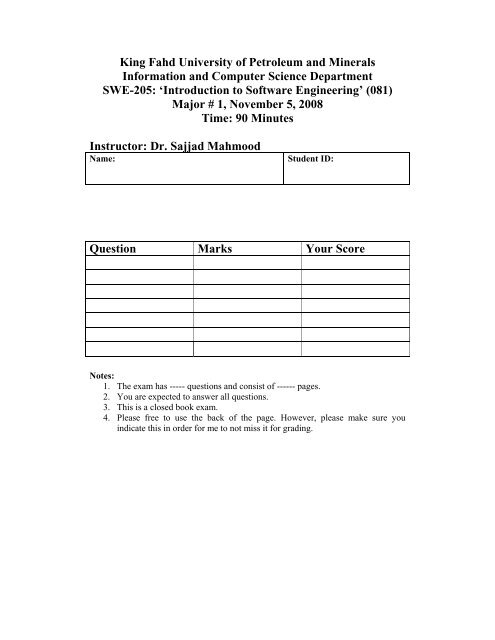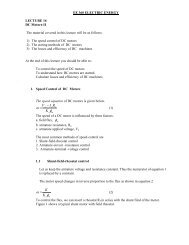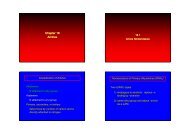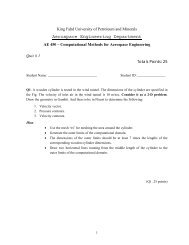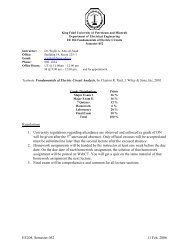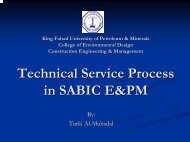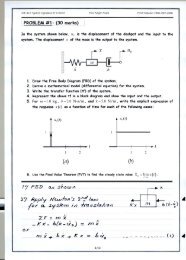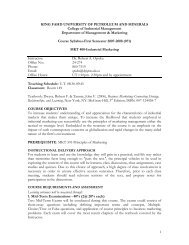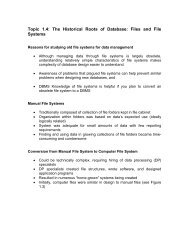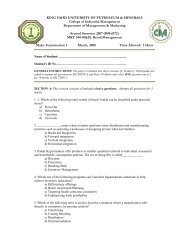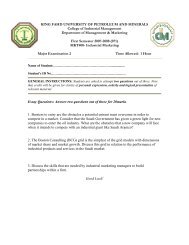PDF - KFUPM Open Courseware - King Fahd University of ...
PDF - KFUPM Open Courseware - King Fahd University of ...
PDF - KFUPM Open Courseware - King Fahd University of ...
Create successful ePaper yourself
Turn your PDF publications into a flip-book with our unique Google optimized e-Paper software.
1. Question 1: True/False & Short Description. [11 + 9 = 20Marks]a. Mark the correct statements as True [T] and the incorrect statementsas False [F][12 Marks, 1 marks each]1. Generic Products are systems which are commissioned by a particular customer. F2. S<strong>of</strong>tware evolution is a process activity where the s<strong>of</strong>tware is modified to adapt itto changing customer and market requirements.3. In Rational Unified Process (RUP), the goal <strong>of</strong> inception phase is to develop anunderstanding <strong>of</strong> the problem domain.4. A s<strong>of</strong>tware design is a description <strong>of</strong> the structure <strong>of</strong> the s<strong>of</strong>tware to beimplemented.5. S<strong>of</strong>tware verification and validation is intended to show that a system conforms toits specification and that the system meets the expectations <strong>of</strong> the customer.TFTT6. A milestone is a project result that is delivered to the customer. F7. Requirements discovery is the process <strong>of</strong> gathering information about the proposedand existing systems8. Risk planning process considers each <strong>of</strong> the key risks that have been identified andidentifies strategies to manage the risk.TT9. Traceability is the set <strong>of</strong> activities that assess the impact and cost <strong>of</strong> the change. F10. Consistency checks means the requirements document should includerequirements, which define all functions, and constraints intended by the system user.11. Functional requirements are requirements that not directly concerned with thespecific functions delivered by the system.FFb. Explain each <strong>of</strong> the following s<strong>of</strong>tware process models. Be brief,concise and to-the-point.[9 Marks, 3 Marks each]The Waterfall ModelThe waterfall model takes the four fundamental process activities(specification, development, validation and evolution) and representsthem as separate and distinct phases.Evolutionary ModelEvolutionary model interleaves the activities <strong>of</strong> specification, developmentand validation.
. State one advantage and one disadvantage <strong>of</strong> Component-based s<strong>of</strong>twaredevelopment.[4 Marks, 2 Marks each]Advantage: Component-based s<strong>of</strong>tware development promotes s<strong>of</strong>twarereuse and it has the potential to reduce s<strong>of</strong>tware development cost andincreasing s<strong>of</strong>tware productivity.Disadvantage: A Requirements compromise is inevitable and this may leadto a system that does not meet the real needs <strong>of</strong> users.c. Describe the role <strong>of</strong> risk analysis in evolutionary process models like thespiral model.[4 Marks]As each prototype is enhanced by iteration through the process steps, boththe technical and management risks are assessed to see if it is still possibleto complete the project which its required functionality with acceptabletime and cost constraints.4. Question 4: Project Management [10 + 3+2+2+3 = 20 Marks]The following table sets out a number <strong>of</strong> tasks, durations anddependencies.Task Duration (Days) DependencyT1 10T2 15 T1T3 10 T1, T2T4 20T5 10T6 15 T3, T4T7 20 T3T8 35 T7T9 15 T6T10 5 T5, T9T11 10 T9T12 20 T10T13 35 T3,T4T14 10 T8, T9
T15 20 T12, T14T16 10 T15a. Draw an activity chart showing the project schedule. [10 Marks]b. Highlight the critical path on the activity chart. [3 Marks]c. What is the minimum duration <strong>of</strong> the project? [2 Marks]d. What will be the minimum duration <strong>of</strong> the project when the duration <strong>of</strong> T3changes from 10 to 15 days?[2 Marks]e. What will be the minimum duration <strong>of</strong> the project when the duration <strong>of</strong> T5is changed from 10 to 15 days?[3 Marks](c) 130 days; (d) 135 days; (e) 130 days5. Question 5: S<strong>of</strong>tware Requirements [18 Marks]a. Identify three methods <strong>of</strong> validating requirements? [6 Marks]1. Requirements reviews2. Prototyping3. Test case generationb. Identify three types <strong>of</strong> non-functional requirements? [6 Marks]
1. Product requirements2. Organizational requirements3. External requirementsc. For all new systems, the requirements engineering process shall start witha feasibility study. The input to the feasibility study is a set <strong>of</strong> preliminarybusiness requirements, an outline description <strong>of</strong> the system and how thesystem is intended to support business processes. Identify three aims <strong>of</strong> afeasibility study.[6 Marks]1. Does the system contribute to the overall objectives <strong>of</strong> theorganisation?2. Can the system be implemented using current technology andwithin given cost and schedule constraints?3. Can the system be integrated with other systems which are alreadyin place?6. Question 6: S<strong>of</strong>tware Requirements [22 Marks]a. An unattended petrol (gas) pump station system that includes a credit cardreader. The customer swipes the card through the reader and then specifiesthe amount <strong>of</strong> fuel required. The fuel is delivered and the customer'saccount is debited.1. For the natural language description <strong>of</strong> the following system,identify the high level requirement.[4 Marks]The system should provide an unattended fuel delivery servicewhere a specified amount <strong>of</strong> fuel is delivered to customers. The
cost <strong>of</strong> the fuel is deducted from the customer's credit cardaccount.2. Identify seven sequences <strong>of</strong> actions to dispense fuel.[14 Marks]1. The customer selects the type <strong>of</strong> fuel to be delivered.2. The customer inputs either a cash limit or maximum <strong>of</strong>amount <strong>of</strong> fuel to be delivered.3. The customer validates the transaction by providing creditcard account details.4. The pump is activated and fuel is delivered.5. The transaction is terminated either when the pump nozzleis returned to its holster or when the customer's fuel or cashlimit is reached.6. A receipt is printed for the customer.7. The fuel stock is updated.b. A model university library system shall provide a financial accountingsystem that maintains records <strong>of</strong> all payments made by users <strong>of</strong> the system.System managers may configure this system so that regular users mayreceive discounted rates.The above mentioned user requirement includes both conceptual anddetailed information. Identify one detail that would have been better leftto the system requirements specification.[4 Marks]The requirement includes detail that the accounting system should supportdiscounts for regular library users. This detail would have been left to thesystem requirements specification.


